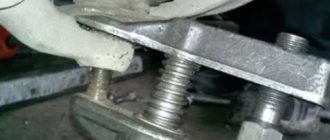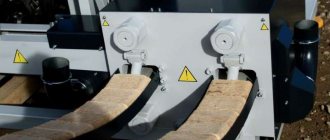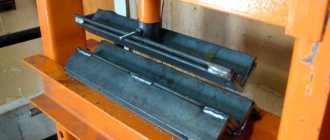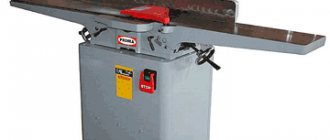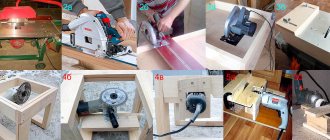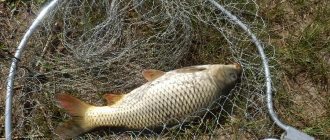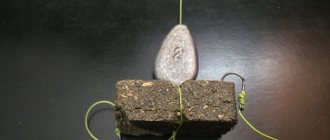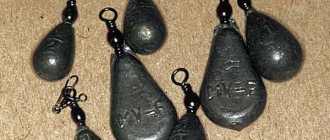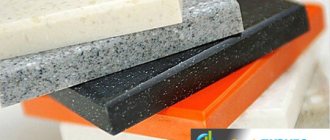Like different types of baits, sinkers of a certain weight and shape can also be made at home. Of course, not all fishermen are mechanics or millers, and not everyone has the opportunity to make metal forms, so plaster or sealant can be used as the mold material. Or contact a familiar craftsman at a local factory for a metal mold.
If the transaction is successful, within a day or two you will receive the necessary molds for casting. But first you need to take care of determining the exact diameter of the future spherical weights and inform the master about it in order to ultimately get weights of the required weight.
If you are not good at mathematical calculations, you can find tables online showing the correspondence between the diameter and weight of a lead ball. It is also worth remembering that balls made of lead and, for example, Wood's alloy with the same dimensions will have different weights, since lead has a higher density.
How to make a mold for casting sinkers from plaster (video)
Lead smelting molds
As noted earlier, lead is cast into molds to produce parts. Casting molds are made from different materials - steel, cast iron, graphite, and aluminum alloys are used in industry. At home, sand, gypsum, silicone and other materials are used. The lead casting mold can be made by hand, but mechanized equipment is most often used. Moreover, in many home workshops you can find hobby mechanical equipment.
Structurally, the mold for casting lead products consists of several parts: 1. The mold itself, as a rule, includes two parts. 2. Fusible or non-fusible rods, guides and locks. To make a plaster mold, you need to prepare two boxes made of wood. Then, gypsum, diluted to a creamy state, is poured into a wooden box. After some time, the plaster begins to harden, at which time the future product can be installed in it. In this case, it should be half immersed in plaster. This will form the first half of the mold. A similar operation must be performed to obtain the second form. After the plaster has dried, the form is ready. In order to be able to pour molten lead during the manufacture of the mold, it is necessary to form a casting hole.
Mold making
You need to prepare the gypsum mixture according to the “powder to water” rule, in a ratio of approximately 1:1, you need to focus on the consistency, it should be creamy.
Pre-lubricate our mold and samples with the prepared fatty cream.
Pour the mixed plaster into the container to fill exactly ½ of the container and tap it on the surface, expelling air bubbles. As soon as the gypsum begins to set, it is necessary to immerse our samples halfway in the hardening plaster. The setting time of the gypsum depends on the brand of the powder itself, the minimum time is 2 minutes, i.e. after 2 minutes we begin to carefully look at the surface of the plaster. As soon as it becomes matte, it’s time!
We insert guides along the edges of our form. It can be anything, I use pieces of wire, toothpicks, lollipop tubes.
Now we wait for complete hardening, 20-30 minutes is enough.
Read also: How to check an example with a column?
Then we lubricate the surface of the mold and the samples recessed in it with our rich cream.
We dilute the plaster again and fill the container to the top. We also remove air bubbles by tapping and leave to harden for the same 20-30 minutes.
After hardening, carefully remove the mold from the container and carefully separate it into two halves, removing the samples
Read also: What kind of word “coffee” is in Russian?
That's it, the form is ready! We leave it to dry for a couple of days near the battery - the water should completely evaporate.
So I made 3 molds with different weights. Before the molds become unusable, the weights cast in them will last me for 2 or 3 seasons). The main disadvantage of such forms is their fragility. Gypsum is a fairly fragile material, so molds quickly crack, caverns and chips appear in them, especially for split molds. Bullet molds last much longer. For example, the uniform shown in the photo in the article is already in use for the second or even third season.
After the mold has completely dried, it is necessary to make sprues. To do this, mark the line of the sprue, connect the mold and drill out the sprue in the shape of a funnel using drills of different diameters. For the top point of the funnel I use a 10.1mm drill, for the bottom I use a 3.5mm drill.
Making lead fishing weights with your own hands
Hi all! Today I want to share my ideas, best practices and experience in making lead weights for spinning fishing.
I’ll say right away: this method is only suitable for small batches and simple shapes of sinkers. For example, I would recommend making collapsible Cheburashkas using aluminum molds, which I use myself)
Before the start of the season, I decided to add weights to my collection - “bullets”, for the increasingly popular jig-rig.
So where do we start? First, we need to prepare a set of materials for making molds for our future sinkers. I make the forms from ordinary building plaster.
I use stainless steel wire with a cross section of 0.8 mm. Also, we will need ordinary disposable containers, any fatty cream, such as “baby”, water and an old spoon.
These are ready-made sinkers, purchased or previously manufactured. Any thing can serve as a model. I made one sample from a real bullet)
The shape can be slightly adjusted with plasticine, but only a little, because... When the gypsum sets, it releases heat and a large volume of plasticine will simply melt. In this case, I took the bullets I had previously made and equipped them with wire loops, fixing it all with green plasticine.
Mold making
You need to prepare the gypsum mixture according to the “powder to water” rule, in a ratio of approximately 1:1, you need to focus on the consistency, it should be creamy.
Pre-lubricate our mold and samples with the prepared fatty cream.
Pour the mixed plaster into the container to fill exactly ½ of the container and tap it on the surface, expelling air bubbles. As soon as the gypsum begins to set, it is necessary to immerse our samples halfway in the hardening plaster. The setting time of the gypsum depends on the brand of the powder itself, the minimum time is 2 minutes, i.e. after 2 minutes we begin to carefully look at the surface of the plaster. As soon as it becomes matte, it’s time!
We insert guides along the edges of our form. It can be anything, I use pieces of wire, toothpicks, lollipop tubes.
Now we wait for complete hardening, 20-30 minutes is enough.
Then we lubricate the surface of the mold and the samples recessed in it with our rich cream.
We dilute the plaster again and fill the container to the top. We also remove air bubbles by tapping and leave to harden for the same 20-30 minutes.
After hardening, carefully remove the mold from the container and carefully separate it into two halves, removing the samples.
That's it, the form is ready! We leave it to dry for a couple of days near the battery - the water should completely evaporate.
So I made 3 molds with different weights. Before the molds become unusable, the weights cast in them will last me for 2 or 3 seasons). The main disadvantage of such forms is their fragility. Gypsum is a fairly fragile material, so molds quickly crack, caverns and chips appear in them, especially for split molds. Bullet molds last much longer. For example, the uniform shown in the photo in the article is already in use for the second or even third season.
After the mold has completely dried, it is necessary to make sprues. To do this, mark the line of the sprue, connect the mold and drill out the sprue in the shape of a funnel using drills of different diameters. For the top point of the funnel I use a 10.1mm drill, for the bottom I use a 3.5mm drill.
Casting sinkers
Now we can start casting the lead weights! To do this we need wire for the ears, lead, a torch or crucible and a clamp.
We bend the ears from the wire using pliers and put them into the mold.
We connect the two halves of the form and fix them with a clamp.
Melt the lead. I have old cheburakhs, tire weights and other lead scrap. I heat up the lead with a gas torch, it literally takes a few minutes, it’s very convenient! Next, pour the lead into the sprues and let it cool, that is, when you pour it into the last mold, the first one has already cooled down, everything is very fast!
Now we separate the mold and remove our weights.
Next we repeat in the same sequence.
Weights are cast very quickly, sometimes before fishing I remember that I have run out of a load of a certain weight, and then, in literally 20 minutes, I cast the dozen or one and a half weights I need. It takes less time than going to the store for the same goods)
In this way, you can experiment with the shapes and weights of sinkers, and invent some special shape of sinkers that are not available in stores. For example, last season I experimented with stick weights, making several versions of non-snagging weights with different lengths and diameters. The weight of such “stick” sinkers can be reduced directly while fishing, thanks to the small diameter of 6 and 8 mm (if you need to reduce the weight, you can simply bite off part of the sinker with pliers). Also, thanks to such diameters, the load passes 95% of hooks!
Another simplest form for casting weights is the “bullet” for Carolina. To make such a mold, you need to pour plaster into any sufficiently high mold, I took the cap from an aerosol can, and simply place the bullet samples coated with the same cream on top with the sharp side into the hardening plaster - that’s it, the mold is ready.
To cast such bullets, it is necessary to insert a “mortgage” made of steel wire, lubricated with ordinary toilet soap, into a mold, and pour lead on top. That's all.
The insert is removed from the bullet, leaving a hole for the fishing line.
Simple options
The simplest thing is to make lead weights using a plaster or sand mold. This method has a number of undoubted advantages:
- accessibility and prevalence of material;
- lead melts at a relatively low temperature - 320°C;
- ease of manufacture.
The use of lead and gypsum when making sinkers yourself has several significant nuances:
- at a temperature of about 200°C, water begins to actively evaporate from gypsum , which leads to destruction of its structure and splitting of the product;
- Lead, when hardened, is pressed into plaster , which makes it almost impossible to remove the sinker without destroying the mold;
- a gypsum workpiece has a large number of micropores , which leads to the need to polish the finished product.
When using sand instead of gypsum, the process of preparing the mold is greatly simplified, however, the requirements for the material of the box in which the workpiece will be located when pouring lead are increased; it is advisable to use a metal support. The product itself will be somewhat less aesthetically pleasing and will require serious polishing.
Wooden mold for casting
It allows you to cast more complex lead weights - composite ones. Just like gypsum, it can withstand repeated use.
The form is made from two planks, the size and thickness corresponding to the future sinker. The planks must be made of hard wood. On each board the contours of the sinker and a groove for pouring lead are drawn. You will have to try hard here, since you need both halves of the casting to match when combined.
Recesses in the planks are cut with a chisel or chisel . They should be a little deeper than required. Also try to eliminate any gaps between the forms through which lead could leak out.
The sinker, smelted in a wooden mold, can be equipped with a wire eye. There are two options: either the eyelet is inserted into the gutter before pouring, or a special groove is made in one of the halves of the mold, where the eyelet is inserted before pouring. In the first option, there is a possibility that excess lead will flood the ear, which will be very difficult to free from it.
Are you wondering what a donkey with a feeder looks like? In the article you will see everything you need to collect it.
In this article we will tell you and show you how to make a donk with an elastic band with your own hands.
The sinker can also be made sliding - to do this, instead of the eye, you need to insert a nail into the mold. After the lead hardens, the nail is removed with pliers and replaced with an empty ballpoint pen refill to protect the fishing line from rubbing with lead.
The process of casting a sinker in a wooden mold is similar to a plaster mold. Just take care to ventilate the room: during casting, the mold will rise a little. Take your time to separate the halves and wait until the lead has completely hardened, only then carefully remove the sinker by the eye. Take the time to sand out seams and rough edges.
Don't be upset if the sinker doesn't turn out symmetrical and solid. Everything can be corrected. Just when remelting, do not forget to add lead - each melt evaporates part of the volume .
Lead Die Casting
Injection molding technology is used when the task is to produce small castings with thin walls.
This technology has certain advantages: 1. High precision castings.2. High surface quality.3. There is no need for further mechanical processing of cast products.4. Possibility of manufacturing workpieces with complex configurations.5. High productivity of the injection molding complex.6. Low number of substandard products.7. Saving money and resources when producing large batches of castings.
Homemade feeders for feeders
For feeder fishing, you can use various types of feeder feeders, both industrial and self-made.
A group of fishermen revealed the name of the secret bait during interrogation.
Category: regional news.
This method allows you to obtain not very attractive products, but they are quite suitable for fishing. One should take into account the fact that the feeder is a consumable element of fishing, and appearance is not of fundamental importance. They can successfully compete with feeders made from curlers or plastic bottles.
The advantages of this method of making feeders
- simplicity - you need to spend minimal time making a mold for casting the load of the feeder;
- ease of giving the desired shape and weight of the feeder;
- The output is not expensive material.
To make your own feeder for feeder fishing, you need the following materials and tools:
Where can I get lead?
Do-it-yourself fishing sinkers are poured from any lead that you have on hand. The easiest way to obtain lead is to go to a tire shop and buy used balance weights. Such lead will cost much less than if you buy sheet lead. You can buy the required number of kilograms and get a large number of weights from them for various purposes. The only thing to consider is the steel pieces molded into the middle of some of the weights. It is advisable to remove them during melting. But you usually don’t come across many such sinkers. The weights can be melted all together without sorting them by density.
The second way to extract lead is from old batteries. It is better to find points where they accept old batteries and buy them at a reasonable price. This is a more complicated method, since you will have to disassemble the batteries to remove the lead.
The third way to get lead out of cable braids. It is made of sheet lead with a thickness of 1, 1.5 and 2 mm. If you know any electricians, ask if they can get this braid. From such lead you can not only cast weights, but also cut strips for feeder feeders.
The most expensive way is to buy lead. It is sold in sheets and ingots. Better, of course, is sheet metal, but its size is very large. In such cases, fishermen unite and buy one sheet together.
You can also make weights with your own hands from old weights, which almost every angler probably has.
One thing is certain: absolutely any lead is suitable for casting sinkers with your own hands. It doesn't matter if it has impurities, or how dense or soft it is. Our task is weights for bottom fishing.
Characteristics of the material and use in the manufacture of sinkers
For those who are just starting their career, experienced fishermen advise not to hesitate to stock up on a whole set of sinkers at once. Both very tiny and quite substantial ones are suitable here. But, this is for the first time, and then, when the fisherman gains experience and thoroughly studies all the nearby bodies of water, it becomes necessary not only to replenish the supply of weights, but also to make them as convenient as possible for fishing. This is where a soft, fusible and fairly heavy metal that does not react with water or air comes to the rescue - lead.
One of the reasons why lead and its alloys have become so popular for casting weights is the availability of the metal. First as the main metal for casting shot, and later as a metal widely used in the automotive industry, in railway transport, and in communication lines, lead, in fact, has never been a big problem. On the other hand, it was possible to melt the metal with a melting point of only 327.5 degrees using kerosene gas or a fire, and it could also be melted in an ordinary large tablespoon or tin can.
DIY catfish sinker
27 July 2022, 13:33
We are talking about sinkers for catching catfish using kwok. If you catch catfish with donks, you can pour out the sinkers even in a tablespoon. However, if you are serious about catching catfish, then special sinkers are needed for donks, which I will tell you about later. Now we have a short note about homemade weights for lines (“cuts”), which are used to catch catfish.
With simple tools and a little lead, you can easily make your own sinkers. This does not even require injection molds or special devices for casting weights.
The simplest do-it-yourself catfish sinkers
To make such sinkers, you need sheet lead, a small anvil, a nail and a hammer. More pliers. Fishermen usually use a cast iron iron as an anvil.
For as long as I can remember, such irons were used to make not only sinkers, but also summer and winter lures and all sorts of fishing little things. Sheet lead is easiest to cut from a suitable cable, but where to get it in our time is your task.
You can flatten any piece of lead with a hammer to the desired thickness.
You need to gradually wind a thin sheet of lead onto a nail or wire of a suitable diameter. Usually the diameter of this wire is 2.5 - 3 mm, so that the finished sinker slides along a cord with a diameter of 2-3 mm.
I don’t even know what to write about this operation: crimping and tapping, tapping and crimping. That's all.
After enough lead has been wound around the nail, the nearly finished sinker is filed.
Device for casting sinkers from shells
In the photo, my casting device was loaded onto a catfish, which was probably more than twenty-five years old. I use old sixteen-gauge brass shells as injection molds.
It is clear that any tube will do instead of sleeves, but sleeves have the advantage of having a hole exactly in the center.
There is not much to explain, since the process of making the sinkers is simple. The sleeve without a capsule is placed on a nail and filled with lead.
After the lead has cooled, the sleeve is torn off from the sinker with pliers, and the sinker is processed with a file. Look at the finished sinkers, cast in such a simple device: the file did not touch the top ones, but the bottom one was turned into an “olive”.
Varieties of sinkers for catfish
- The sinkers described above are sliding ones. These are the sinkers that are most common among catfish hunters with quok.
- There is another popular type of edge sinker: with wire rings. I don’t like such sinkers, since they contain “noisy” elements - wire sticking out of them. Semenych, like most “old school” fishermen, did not use such sinkers. On some of his cords (“edges”) the weights were made of very thin sheet lead, carefully wound directly onto the cord!
- I came up with my own sinkers a long time ago. They are much more complex than those described above, but increase the number of catfish approaches. Each of my sinkers has its own transparent leader. Such a sinker is much less alarming to catfish than one traditionally attached directly to the cord (“cut”). At the same time, the leash absorbs the jerks of the hooked catfish. I will dedicate a separate page of the site to my sinkers, because they deserve it.
- Buy sinkers for catching catfish using kwok
Source: https://chursin.info/blog/index_post_1532683989.htm
Safety precautions
When casting sinkers over an open fire, fire safety requirements must be observed. Keep water nearby to extinguish potential fires. NEVER pour it into a container with lead.
The room should be well ventilated, ideally have a hood. The melting process should not be left unattended, but you need to choose thick clothing.
Long sleeves and gloves are required to protect your hands from burns if lead is splashed. Make sure that there are no flammable substances or flammable objects near the stove, fire or electric crucible. This especially applies to clothing. In addition, it is very difficult to remove the chemical smell of lead from it.
Making simple disposable molds
The fragility and destruction of the gypsum structure when water evaporates makes it difficult to use this material for reusable use. However, as a disposable and easy-to-make mold, gypsum is ideal.
Make it a rule, on every fishing trip, the first thing you do is start.
To make a shape for a simple sinker you need:
- Prepare a box for pouring the mold; it should consist of two parts, tightly mounted on top of each other; you can use small boards fastened with screws;
- Dilute the gypsum to a creamy state, while trying to ensure that there are no air bubbles in the resulting mixture, since voids then appear in their place;
- The first layer of gypsum is poured into the lower part of the box, which should harden a little;
- The required sinker is immersed halfway into the plaster and, using a drill, a hole is made in the plaster on the side of the workpiece for pouring lead (it is better to insert cylinders of suitable size into these holes);
- The surface of the frozen layer is greased with vegetable oil so that the halves of the mold can then be easily separated;
- The second part of the box is installed on top, into which gypsum is poured;
- After the entire structure has hardened, the box is disassembled, both parts of the mold are separated and the sinker and cylinders of the filling channels are removed;
- The mold is cleaned and covered from the inside with a layer of soot using soot from a burning candle;
- The ears and loops for the sinker are secured, the mold is assembled and secured with wire;
- The finished form should dry well; to do this, you need to place it in a dry place for 1-2 days or use the oven.
The easiest way to make a cone-shaped sinker is to use a paper cone in the sand:
- A paper blank (a piece of paper rolled into a cone) is inserted into any container tightly filled with sand; a metal loop for a sinker is inserted into the sharp end of the cone;
- Lead is melted and poured into a paper cone;
- Part of the cone burns, but during this time the lead has time to cool a little and begin to harden;
- The cooled workpiece is removed from the sand and processed with a file.
You can use aluminum foil instead of paper.
The material for the sinker is also quite common and accessible, so even complex sinkers can be made independently using appropriate blanks
How to make a fishing sinker
This technology is suitable for the manufacture of various equipment elements and fixtures. You can cast sinkers for bottom fishing, sliding and stationary, eccentric sinkers for jig fishing, “bullets” for Texas equipment, cut-offs, depth gauges, etc.
All this can be done at home, and without special injection molds. When fishing in the current, “cone” sinkers are convenient. To begin with, a cone is made from whatman paper or thick paper.
Office equipment paper and PVA glue or thick paper on which some newspapers and magazines are printed are excellent for these purposes.
Next, you need to glue it together, and then wrap it with thin wire for reliability. Sinkers can have different sizes. The most successful is a sinker that has 1.5 centimeters on the upper cut and a height of 4 or 3 cm. From below, using scissors, you need to cut the tip of the cone so that the hole is about 1.5 mm in diameter.
Next, a ring is made from thin copper wire, and its ends need to be braided into a pigtail, which is then inserted into the hole at the end of the form. If necessary, I insert a wire loop, fastener, swivel, etc. into the top of the cone. If a through hole is necessary, then along the axis of the mold I install a thin metal knitting needle, pre-greased.
I place this paper cone in a yogurt cup filled with sand and fill it with molten lead. I try to use sand that has been washed and always dry! After 2-3 minutes, the castings can already be removed from the sand with pliers and cooled under running water.
Using wire cutters and a file, I bring the casting to the desired size and shape. Having flattened the conical sinker with a hammer, I get a flat one - for fishing in the current.
By changing the shape of the pound, you can expand the range of products produced: you can get sliding weights that are oval in cross-section, eccentric jig heads, etc.
Using your imagination, you can use cone castings to make many useful and very cheap products needed for fishing. But finally, I think it would be useful to remind you that work with lead must be done outdoors or indoors with good ventilation!
How to make a sinker for fishing - photo
Source: https://orybe.com/social/svoimi-rukami/kak-sdelat-gruzilo-dlya-rybalki/
Casting sinkers
Now we can start casting the lead weights! To do this we need wire for the ears, lead, a torch or crucible and a clamp.
We bend the ears from the wire using pliers and put them into the mold.
We connect the two halves of the form and fix them with a clamp.
Melt the lead. I have old cheburakhs, tire weights and other lead scrap. I heat up the lead with a gas torch, it literally takes a few minutes, it’s very convenient! Next, pour the lead into the sprues and let it cool, that is, when you pour it into the last mold, the first one has already cooled down, everything is very fast!
Now we separate the mold and remove our weights.
Next we repeat in the same sequence.
Weights are cast very quickly, sometimes before fishing I remember that I have run out of a load of a certain weight, and then, in literally 20 minutes, I cast the dozen or one and a half weights I need. It takes less time than going to the store for the same goods)
In this way, you can experiment with the shapes and weights of sinkers, and invent some special shape of sinkers that are not available in stores. For example, last season I experimented with stick weights, making several versions of non-snagging weights with different lengths and diameters. The weight of such “stick” sinkers can be reduced directly while fishing, thanks to the small diameter of 6 and 8 mm (if you need to reduce the weight, you can simply bite off part of the sinker with pliers). Also, thanks to such diameters, the load passes 95% of hooks!
Another simplest version of the mold for casting weights is the “bullet” for Carolina. To make such a mold, you need to pour plaster into any sufficiently high mold, I took the cap from an aerosol can, and simply place the bullet samples coated with the same cream on top with the sharp side into the hardening plaster - that’s it, the mold is ready.
To cast such bullets, it is necessary to insert a “mortgage” made of steel wire, lubricated with ordinary toilet soap, into a mold, and pour lead on top. That's all.
The insert is removed from the bullet, leaving a hole for the fishing line.
Stages of making fishing sinkers
As I wrote earlier, there is nothing complicated in this process. First you will need to melt the lead thoroughly.
How to melt lead for fishing weights
For this purpose, I use a very old (no longer needed) saucepan and a gas stove. I simply place the crushed pieces of lead on the bottom of the vessel and keep it on the fire until they turn into shiny / “floating” droplets. Which indicates that the lead has already warmed up to a critical temperature, which means the temperature we need.
Warming up casting molds
While the lead is successfully melting at the bottom of the pan, I slightly heat up the casting molds themselves in order to avoid the formation of unevenness or “gaps” on the weights when casting them. In addition, I must note that pouring molten lead into cold molds is very dangerous! Since it (due to a sharp temperature change) can “splash” directly onto your face, thereby causing a long (!) non-healing burn.
We fix the forms in a vice
I securely clamp the normally heated casting molds in a vice, which (in turn) I attach to the edge of the table. In fishing stores you can choose a variety of molds for casting sinkers, for example, with clamps or with welded handles. But in today's example (you can look at the photo), I'm making exactly three-ounce/sliding weights. Therefore, in this case, a specific rod passes directly through the center of the form.
We begin the filling process
Once the lead is completely melted, using a regular tablespoon (only with a makeshift notch on the side, which I will talk about later), I carefully “scrape” all the debris from its surface. And then, with the same spoon, I scoop it up (a little at a time) and carefully pour it into the molds.
Form for sealant weights
You can make a mold for making sinkers or spinning baits yourself without much difficulty, using plaster or silicone sealant, as well as a ready-made sample. For example, it is easy and also very unusual to make a mold from a sealant like “Hermesil” and the like. The main factor when choosing a sealant is its ability not to change physical properties when exposed to high temperatures.
Making molds for plaster weights
- The melting point of lead, that is, the state from which lead changes from solid to liquid, is 320 degrees.
- At a temperature of 200 degrees, water begins to evaporate from the gypsum mold, the hardness of the gypsum is destroyed and it begins to crumble.
- When lead hardens in a mold, it tends to be pressed in, and it becomes impossible to pull out the sinker without destroying the inner edges of the mold, especially for heavy carp sinkers weighing over 100 grams with spikes and corners in shape.
- The product obtained by this method is subjected to polishing, since the plaster mold is impregnated with micro pores, they cannot be removed with Goya paste, the mold can only be smoked, coated with chalk or talcum powder. Soot, chalk, talc allow lead to slide freely along the inner surface of the mold and fill all voids. These components affect the smoothness, quality of the sinker and allow it to be easily removed from the mold.
- Even dental plaster is not able to withstand repeated tearing of a pressed sinker out of shape.
- A plaster mold can be impregnated and coated from the inside with various sealants and chemical compounds, but this does not solve the issue of water evaporation.
- The plaster weight mold needs to be closed and opened. Can this mold withstand repeated opening as the lead is pressed into the mold?
Forms for regular use
A plaster mold, even a very well made and dried one, will sooner or later collapse and you will have to make a new one or use a product suitable for frequent use.
Of course, for repeated use, molds made of heat-resistant steel or cast iron are best suited, but making these yourself is almost impossible. But cement is good for creating a melting mold, although this will require a little work.
Materials and tools for reusable uniforms:
- formwork material (wooden boards);
- liquid soap;
- cement;
- round file;
- fine sandpaper;
- clamp;
- cylinders for inserting into the filler hole;
- wire for making loops for the sinker.
For repeated use, molds made of heat-resistant steel or cast iron are best suited, but making these yourself is almost impossible
Making a mold for casting weights
Making a mold is not that difficult. First, we take a small box and completely fill it with high-quality sealant. When filling, be careful not to form bubbles.
Next, the original weight needs to be lubricated with a solution of wax or paraffin in gasoline. After drying, the sinker on a thin wire is completely lowered into the sealant, but it should not touch the walls of the box itself.
The weight sample should remain in this position until the sealant hardens. Due to the characteristics of the sealant, this process can last a couple of days or drag on for 5-6 days. Do not remove the weight until complete polymerization.
After the substance has hardened, we cut a small hole through which we extract a sample of the sinker. The elastic form is ready, which means you can try to make your own weight from lead or its alloy.
The metal is poured through the same hole that you made earlier to remove the original sample weight. Thanks to its unique physical properties, the silicone mold allows you to easily remove homemade sinkers or baits, after which it returns to its original form and is ready for use again.
Pour out the cone weights
Donkers and spinning fishermen often use hand-made conical weights. The former are used because they fly far and accurately, while spinners use them in spaced rigs. Making these weights yourself is very easy. You don't even need forms. We will need hard paper, with which we will make cones in the form of small bags.
We also need thin and stiff wire. From it we will make eyelets through which the weights will be attached to the main fishing line.
We will pour the sinkers with our own hands in exactly the same way as last time. Instead of a gas burner, you can use a portable one with two burners. It will be possible to pour in two containers to make the process faster. In this case, place the jars on the stove at intervals of 5 minutes. The lead has melted in one, pour it straight into the molds. After this operation, the lead should melt in the second container.
We insert wire staples into the paper molds so that the eye sticks out from the top of the cone. We immerse the molds in the ground so that they take a vertical position. We select the size of the molds experimentally. We estimate by eye what kind of weight we need. As a standard, you can take a 35 gram weight and look at it. It will be enough to pour out the first batch of sinkers for fishing with your own hands. We will use the resulting weights as samples when we make molds for the next batches.
The pouring process is identical to the previous one. You can use an unnecessary metal mug as a container for lead. It is convenient to take it by the handle and pour lead from it. To avoid burning your fingers, it is better to wear gloves on your palms. After pouring, you should wait a little and remove the weights from the molds. We just tear off the paper without sparing, since initially the molds are disposable.
Technology for making lead weights at home
Casting lead sinkers, despite the ease of technology and availability of materials, is still a mini metallurgical production, so before starting work it is necessary to at least superficially study the basics of metal melting. And although there is nothing special here, it is very important to listen to advice and instructions - both the result of the work and the safety of the work depend on it.
Materials
For the work you will need several types of materials - plaster, cardboard, tape, twine, wax or paraffin, and of course, lead.
Plaster or alabaster is usually used to make molds. Gypsum is more reliable than alabaster, but alabaster is more affordable. These two materials are required to make casting molds.
The auxiliary material for the work will be wax or paraffin. From them, models of future sinkers are made.
Clamps are used to secure the halves of the forms, but it is cheaper and easier to use twine or a clothesline, or, in a very modern way, adhesive tape.
Lead for melting can be found at any scrap metal collection point. Not only rechargeable battery scrap is scrapped; often lead-sheathed communication cables, lead alloys such as babbitt or typographical lead font are scrapped.
Mold making
The classic method of making a mold consists of sculpting a sinker model from wax or paraffin and then casting a reusable mold from plaster or alabaster.
Several models of sinkers are made from wax or paraffin. In principle, you can use plasticine, but then, in order for the model to separate from the plaster mold, it will be necessary to lubricate it with Vaseline or fat-based hand cream. After receiving the models, a gypsum solution is made and poured into a plastic or cardboard mold, so that the top surface is as smooth as possible. Until the plaster completely hardens, the model is pressed halfway into it at a distance of 1-1.5 cm from the top edge of the mold. After final hardening, the entire surface, including the model, is smeared with Vaseline, grease or fat-based cream and filled with plaster on top. When pouring, make sure that the height of both forms is the same.
Pros and cons of lead sinkers
Like any other tackle, a lead sinker has its pros and cons. Here, to understand, you need to take into account both the consumer qualities necessary for fishing, and those issues that relate to manufacturing issues, for example, the availability of materials or the complexity of the work.
According to experienced fishermen, the main parameters that a sinker must meet should include:
- Sinker weight – it must be heavy to ensure accuracy of casting the tackle;
- Have a streamlined shape - in the air, the irregular shape of the sinker, rectangular shape or roughness greatly influences the casting distance and accuracy, and in the aquatic environment this creates turbulence that scares away fish, prevents the bait from being guided correctly, and contributes to entanglement in aquatic vegetation;
- The casting should not only have smooth shapes, but also provide reliable fastening to the fishing line;
- Be inconspicuous, not stand out against the background of bottom vegetation, have, if possible, a matte color that is natural for the aquatic environment;
- Made from available materials;
- If possible, be manufactured in the simplest conditions using a minimum of auxiliary tools;
Among the advantages of lead weights is the availability of the material.
As you can see, the basic requirements for weights are quite simple and are quite applicable to a material such as lead. Therefore, the positive aspects of lead sinkers are:
- Availability of material;
- Ease of working with lead castings;
- The ability to independently smelt the required amount of sinkers;
- Cheap production, even if one or two are lost, it will not be a big tragedy;
- The ability to independently choose the weight and shape;
- The material has a natural color, ideal for the environment of most bodies of water.
However, it is worth mentioning the problems associated with the manufacture of lead weights:
- The work carries some risk of injury;
- It is not always possible to achieve results the first time;
- To work, you need a tool.
Lead casting process
Lead alloys are multicomponent compositions that can contain up to 10% copper. Its presence significantly increases the melting point. The second most important component is antimony. The main advantage of lead alloys is that molds of almost any configuration can be used to work with them, at fairly low pressures. The melting point of lead is quite low - 325-350 degrees, and this allows you to cast lead parts at home.
For casting lead, injection molding technology is used. Melting furnaces use equipment that runs on various types of fuel - gas, fuel oil, coke and electrical energy. This equipment must meet the following requirements: 1.
minimum time spent on melting. 2. Minimal material loss. 3. Minimum fuel consumption. 4. Safe and comfortable work. To obtain molten lead and its alloy, the temperature provided in the furnaces is sufficient to melt the lead. Lead is processed in crucible furnaces. The main difference between this class of equipment is that the melt does not come into contact with fuel combustion products. Lead and its alloys are melted in furnaces with metal or graphite crucibles, which can operate on several types of fuel.
Crucible furnaces are produced in two versions: • stationary; • rotary. Furnaces with graphite crucibles for casting make it possible to melt various metals - lead, tin, and aluminum. Moreover, the transition from one metal to another occurs with minimal costs. But crucibles made of graphite have low durability and therefore crucibles made of cast iron are more often used.
The procedure for obtaining lead parts is as follows. Lead pigs or scrap are immersed, where the transition of lead from solid to liquid occurs. After this, the liquid material is poured into prepared models. The principle of castings in industry and households is the same, the key differences are only in scale.

